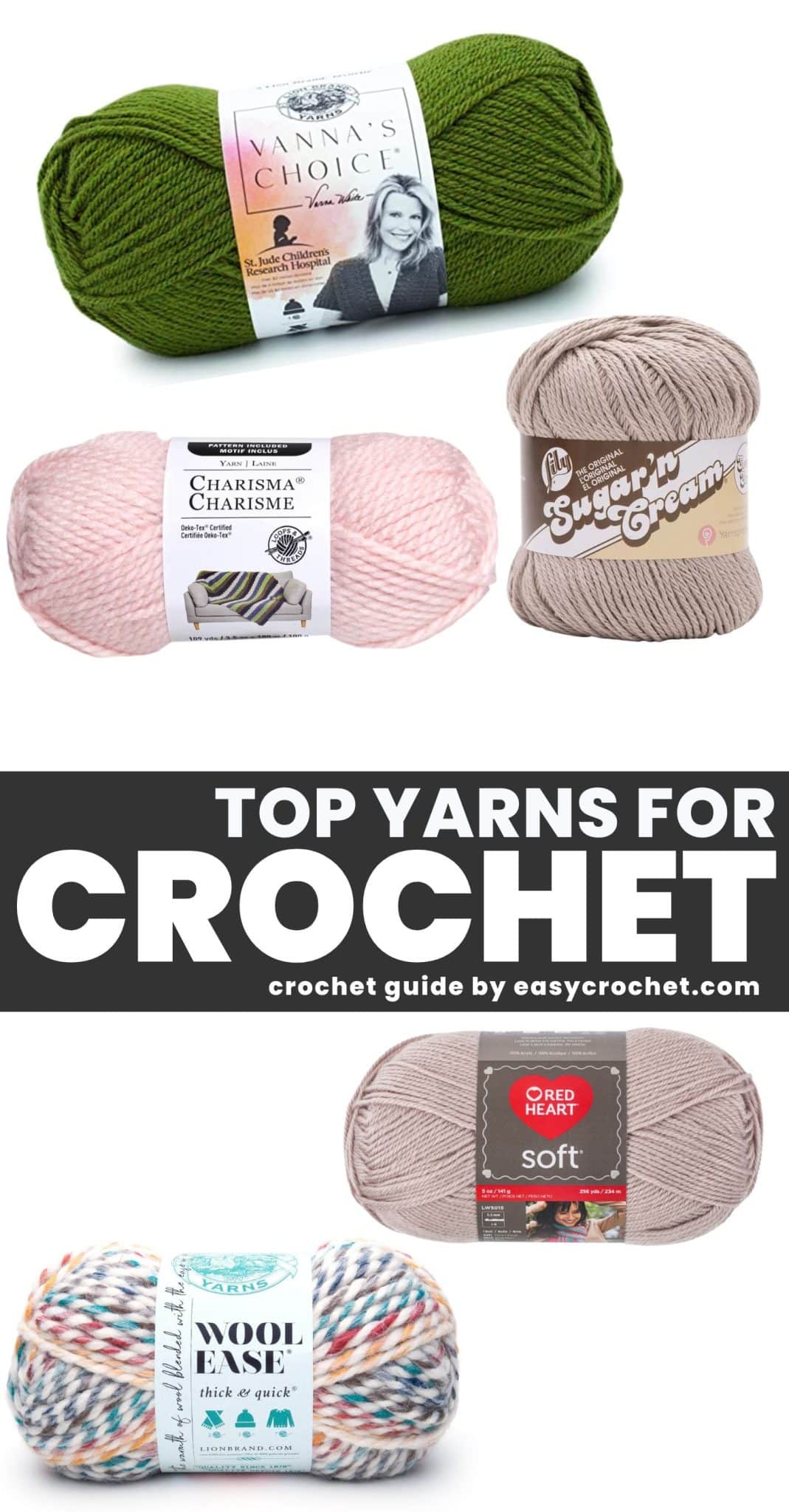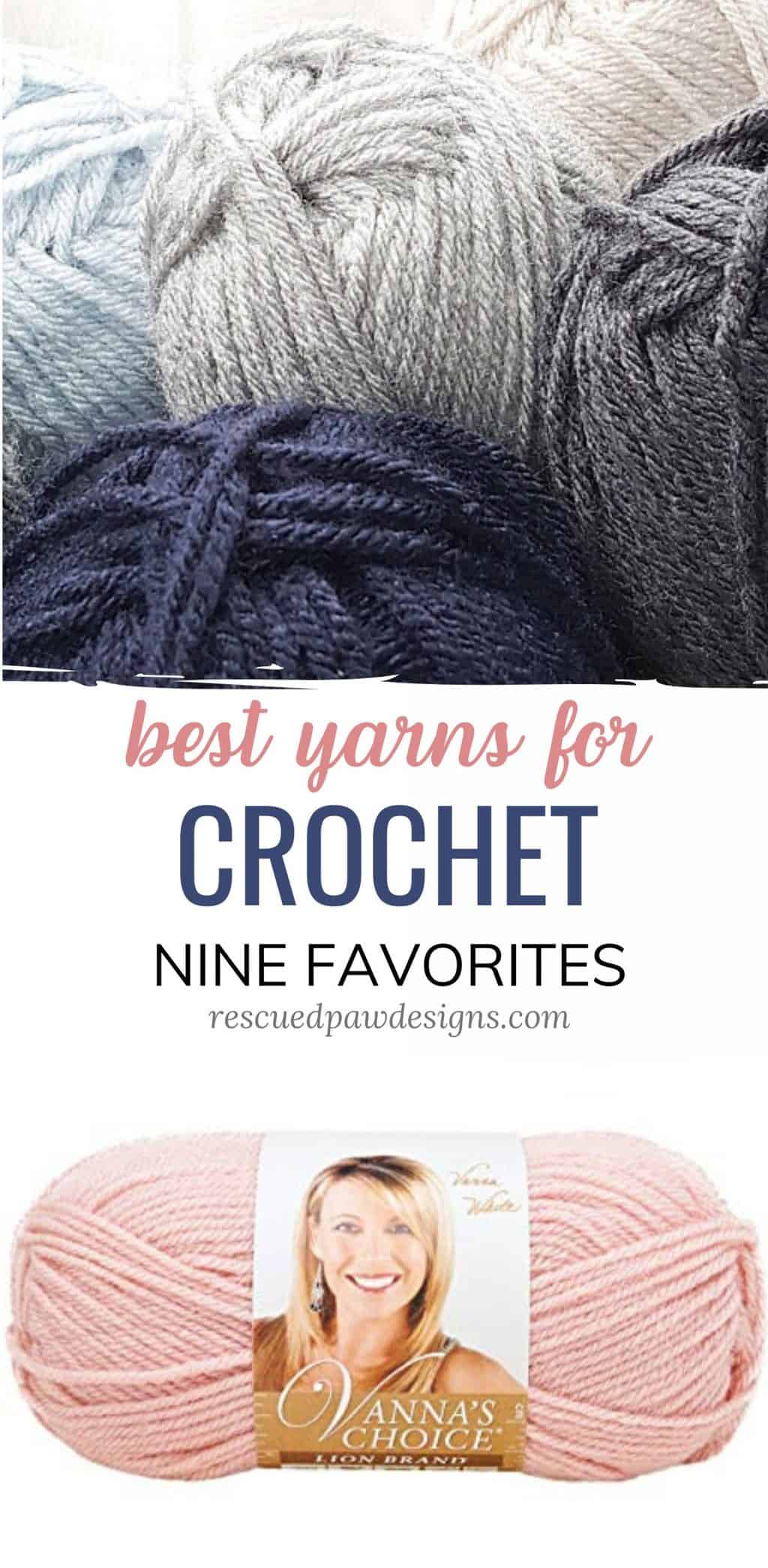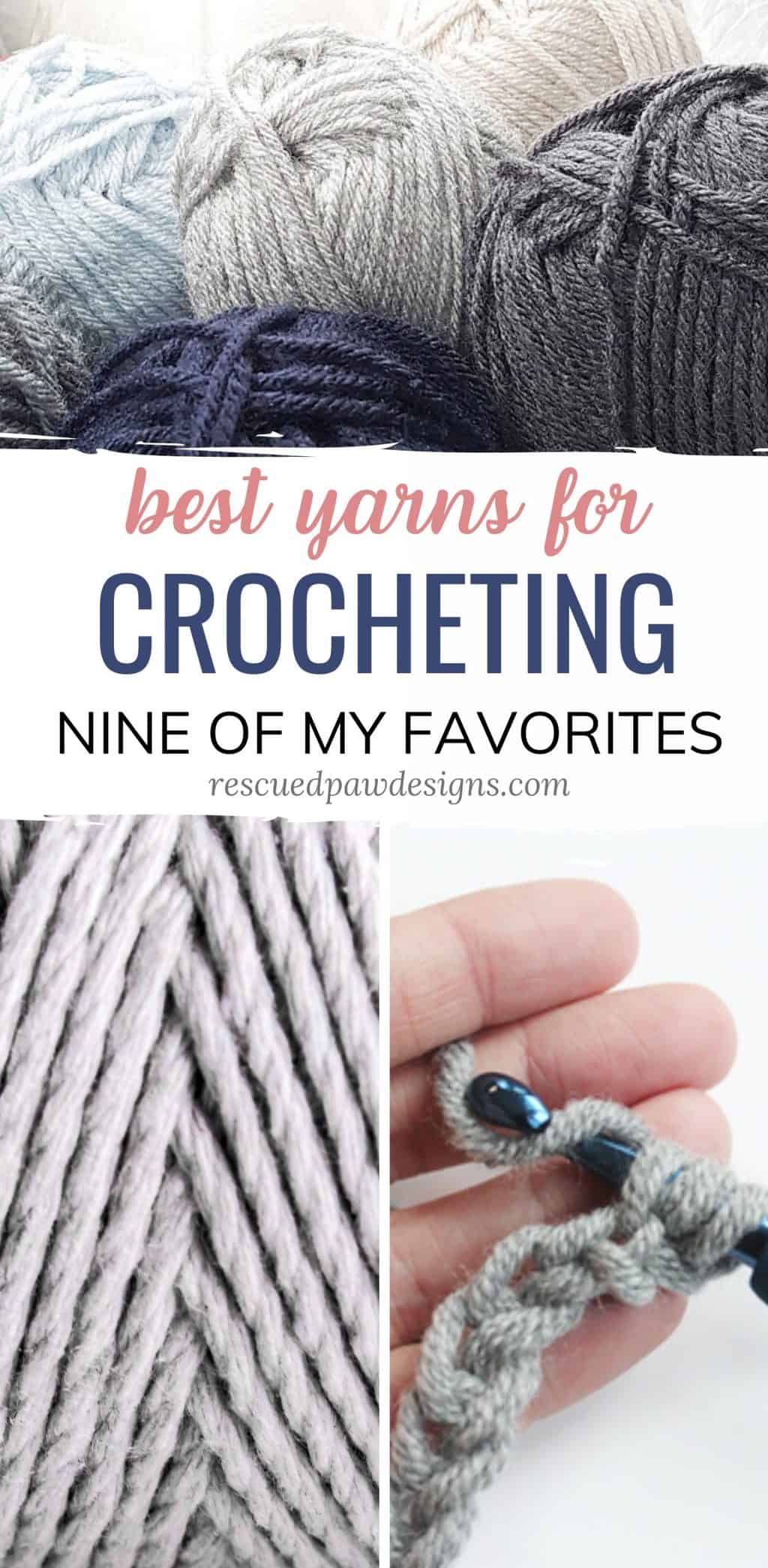The Best Yarns for Crochet
Every crocheter (and knitter) knows that collecting yarn is a big part of the thrill of being a fiber artist! With so many brands, colors, and weights of yarn out there, it can be hard to limit yourself.
I picked out a few of my favorite yarns to crochet with below, so you can try to make your choice a little easier! Plus, I’ve also included some common questions about yarn with some answers that may help make your choices a bit easier.
Have fun yarn shopping and if you have any questions about the yarns named in this list be sure to ask.

Choosing a good yarn to crochet with can be tough when you are going yarn shopping for the first time. The three most common choices for yarns when someone is first learning to crochet are wool, acrylic, and cotton. Most yarns that fall into these categories are affordable and easy to find at craft stores, yarn stores, and online at places like Amazon, WeCrochet or Lionbrand.com.
Below, I will break down the list below into the three yarn type categories I mentioned above, Wool, Arcylic, and Cotton (all great yarns for beginners FYI) for easy reference. This way, you can hopefully make your choice of yarn a quick and simple one!
Common Questions About Yarn for Crochet
When it comes to yarn for crochet, beginners and experienced crafters alike often have various questions. Here are some common questions about yarn for crochet:
What is yarn weight, and why does it matter?
- Yarn weight refers to the thickness of the yarn strand. Different yarn weights are used for different types of projects. Thicker yarns are generally used for cozy blankets and sweaters, while finer yarns are suitable for delicate shawls or baby items.
How do I choose the right yarn for my project?
- Consider the pattern’s recommended yarn weight and fiber content. Choose a yarn that complements the project’s purpose and style. For example, cotton yarn is great for summer wear, while wool is ideal for warm winter items.
What are natural and synthetic fibers?
- Natural fibers, like cotton, wool, and silk, come from plants or animals. Synthetic fibers, like acrylic and nylon, are man-made. Each type of fiber has its own characteristics, such as softness, durability, and warmth.
What does “ply” mean in yarn?
- Ply refers to the number of strands twisted together to create the yarn. Single-ply yarn has one strand, while two-ply yarn has two strands twisted together. Ply can affect the yarn’s texture, strength, and appearance.
How much yarn do I need for my project?
- The pattern will usually specify the amount of yarn required. It’s important to follow these guidelines, especially if you’re making a garment, to ensure you have enough yarn to complete your project. Take a look at how our detailed post about how much yarn you will need for certain crochet projects.
How do I read yarn labels?
- Yarn labels provide essential information such as fiber content, weight, yardage, care instructions, and dye lot. Understanding these labels will help you make informed choices and match the right yarn to your project.
What is a gauge swatch, and why is it important?
- A gauge swatch is a small sample of your chosen yarn and hook size to determine how many stitches and rows you’ll get per inch. It helps ensure your finished project matches the dimensions of the pattern and fits correctly.
Can I substitute one yarn for another in a pattern?
- Yes, you can substitute yarn, but it’s essential to match the recommended weight and fiber properties as closely as possible to achieve the desired outcome. Keep in mind that the finished project might look and feel different with a different yarn.
How do I handle color changes in a project?
- Color changes can be managed by weaving in the new color as you crochet, or using the “carry-along” method for stripes. You’ll need to secure and hide the yarn tails neatly within your stitches.
How do I care for crochet items made with different yarns?
Different fibers have varying care requirements. Read the label for washing and care instructions specific to your yarn. Some yarns are machine washable, while others require hand washing and blocking.
Remember, the more you experiment with different yarns, the better you’ll become at understanding their unique qualities and how they can be used to create beautiful crochet projects.
The Most Common Types of Yarn for Crochet
Choosing a good yarn to crochet with can be tough when you are going yarn shopping for the first time. The three most common choices for yarns when someone is first learning to crochet are wool, acrylic, and cotton.
- Wool
- Acrylic
- Cotton
Most yarns that fall into these categories are affordable and easy to find at craft stores, yarn stores, and online at places like Amazon, WeCrochet or Lionbrand.com.
Wool Yarn
Wool yarn is a type of yarn made from the fibers of sheep’s wool. It is one of the most traditional and widely used natural fibers for crafting, including knitting and crochet. Wool yarn comes in various forms, including different weights, colors, and textures, making it versatile and suitable for a wide range of projects.
Key characteristics of wool yarn include:
- Warmth: Wool is known for its excellent insulation properties, making it a popular choice for cold-weather garments and accessories like sweaters, scarves, and hats.
- Durability: Wool fibers are naturally strong and resilient, making wool yarn a durable option for items that will see frequent use.
- Elasticity: Wool has a natural elasticity, which means it can stretch and bounce back to its original shape. This is particularly useful for items like socks and garments that need to maintain their shape over time.
- Moisture Absorption: Wool can absorb a significant amount of moisture without feeling wet, making it suitable for both warm and cool environments. It can wick away moisture from the body, keeping you comfortable.
- Natural Crimp: Wool fibers have a natural crimp or waviness, which contributes to their elasticity and ability to trap air, enhancing their insulating properties.
- Variety: Wool yarn comes in different types and grades, such as merino wool, alpaca wool, and more, each with its own unique texture, softness, and characteristics.
- Dyeability: Wool yarn can hold dyes well, resulting in vibrant and richly colored projects.
- Texture: Depending on the processing, wool yarn can vary in texture from smooth and fine to coarser textures, offering a range of options for different projects.
It’s worth noting that while sheep’s wool is the most common source of wool yarn, other animals like alpacas, llamas, and goats (such as cashmere and mohair) also provide fibers that are classified as wool and can be used to create yarn.
Acrylic Yarn
Acrylic yarn is a type of synthetic yarn made from acrylic fibers, which are derived from petroleum-based chemicals. It’s a popular choice for knitting, crocheting, and crafting due to its affordability, versatility, and ease of care. Acrylic yarn comes in various weights, colors, and textures, making it suitable for a wide range of projects.
Key characteristics of acrylic yarn include:
- Affordability: Acrylic yarn is generally less expensive than natural fibers like wool or cotton, making it a budget-friendly option for crafters.
- Durability: Acrylic fibers are strong and durable, making acrylic yarn a good choice for projects that will see regular use or need to withstand wear and tear.
- Hypoallergenic: Acrylic yarn is hypoallergenic, which means it is less likely to cause allergies or sensitivities in individuals who are sensitive to natural fibers like wool.
- Color Retention: Acrylic yarn holds dye well, resulting in vibrant and long-lasting colors. This makes it a great option for projects that require a wide range of colors or bold color choices.
- Low Maintenance: Acrylic yarn is easy to care for. It is machine washable and often suitable for tumble drying, which makes it ideal for items like blankets, baby clothes, and everyday wear.
- Variety: Acrylic yarn comes in a variety of textures, from smooth and soft to textured and bulky, allowing crafters to choose the right yarn for their desired project.
- Resistance to Moths and Mildew: Unlike natural fibers, acrylic yarn is not susceptible to damage from moths or mildew, which can be a concern when storing natural fiber items.
- Less Likely to Shrink: Acrylic yarn is less likely to shrink when exposed to water and heat compared to some natural fibers.
- Stretchiness: Acrylic yarn has a degree of stretch, which can be useful for items that need a little extra give, like hats or socks.
While acrylic yarn offers many advantages, it’s important to note that some crocheters and knitters may prefer the feel and qualities of natural fibers like wool, cotton, or silk. Acrylic yarn can lack the breathability and luxurious feel of these natural fibers. Additionally, acrylic fibers may not have the same level of environmental sustainability as natural fibers.
However, acrylic yarn remains a practical and widely used choice for a variety of crafting projects, especially when considering factors such as cost, ease of care, and color options.
Cotton Yarn
Cotton yarn is a type of yarn made from cotton fibers, which are obtained from the cotton plant’s seed hairs. It is a natural fiber that has been used for centuries in various forms, including clothing, textiles, and, of course, yarn for crafting. Cotton yarn is well-known for its softness, breathability, and suitability for a wide range of projects.
Key characteristics of cotton yarn include:
- Softness: Cotton yarn is soft and comfortable against the skin, making it a popular choice for garments, baby items, and accessories.
- Breathability: Cotton fibers allow air to circulate, making cotton yarn ideal for warm-weather clothing like summer tops, beach cover-ups, and lightweight scarves.
- Absorbency: Cotton has excellent absorbent properties, which means it can wick moisture away from the body, making it suitable for items like dishcloths, towels, and washcloths.
- Hypoallergenic: Cotton yarn is generally hypoallergenic and less likely to cause allergic reactions or sensitivities in individuals with sensitive skin.
- Durability: While cotton yarn is not as strong as some synthetic or animal fibers, it is still relatively durable and can hold up well to regular use.
- Versatility: Cotton yarn comes in various weights, from fine to bulky, and can be used for a wide range of projects, including garments, home décor, and accessories.
- Easy Care: Cotton yarn is typically machine washable and can withstand repeated washing without losing its color or shape. However, some cotton yarns may require special care instructions, so it’s important to read the label.
- Dyeability: Cotton yarn can be dyed in a variety of colors, though the colors may not be as vibrant or long-lasting as those in acrylic or synthetic yarns.
- Environmentally Friendly: Cotton is a renewable and biodegradable resource, which can appeal to crafters who are conscious of environmental considerations.
- Less Stretch: Cotton yarn has less natural stretch compared to some other fibers, so it’s important to take gauge and tension into account when working on a project.
Cotton yarn is a popular choice for a wide range of crochet and knitting projects, including clothing, home décor, dishcloths, market bags, and more. It’s especially favored for its softness and suitability for warmer climates.
Below, I will break down the list below into the three yarn type categories I mentioned above, Wool, Arcylic, and Cotton (all great yarns for beginners FYI) for easy reference. This way, you can hopefully make your choice of yarn a quick and simple one!
My Favorite Yarns for Crochet Patterns
I can’t wait to help you out a bit by telling you about my NINE FAVORITE and probably the best yarns to use for crochet patterns and other projects. If you have a yarn that is a must-use, please let me know about it in the Easy Crochet Facebook group. We are more than happy to help answer any questions about yarn that you’d like to use in an Easy Crochet project.
I hope you enjoy this list of my favorite yarns to crochet and design patterns with!
The Best Wool Yarn for Crochet Patterns
The list includes wool & wool blend yarns, which are all affordable to crochet big projects with.
Lion Brand Wool-Ease Thick & Quick – This 20% wool yarn is a great one to try because it is bulky and works up fast. I used it when I designed the Jane crochet blanket a couple of years ago, which is a quick project if you are looking for one. 😉 Take a look at the Jane.
Lion Brand Woolspun – This bulky 5 weight 80% Acrylic, 20% Wool fiber is one of the best yarns for crocheting with! It is easy to crochet with and has a wonderful texture. I have designed quite a few crochet patterns with Woolspun over the years like my chained ear warmer pattern and think you’d love it too!
The Best Acrylic Yarn for Crochet Patterns
This list includes some of the best yarns for crochet beginners such as Red Heart Soft and Vanna’s choice since they are both four weight yarns and easier to use than a thinner or thicker yarn when first learning to crochet.
Red Heart Soft Yarn – This fiber, as the name suggests, is a SOFT yarn that is easy to use to crochet patterns. You can pick from over 40 different colors that are a mix of solids and variegated looks. I used RHS to create my son’s favorite crochet blanket a few years ago, which you can find on the blog.
Lion Brand Vanna’s Choice – When it comes to this yarn, I am a little biased. I LOVE it. LOVE LOVE LOVE it! It washes up beautifully and holds up to wear. I have three children, so when I make them something, this is my go-to yarn! If you’d like to see crochet patterns designed with Vanna’s Choice on the blog, be sure to check them out for some pattern inspiration.
Loops & Threads Charisma Yarn – This chunky weight #5 yarn is a favorite of mine from the Michaels brand Loops & Threads. It works up lovely and is available in a wide variety of colors. This yarn looks great in scarves, shawls and cowls. Take a look at the crocheted ombre cowl I designed using Charisma yarn, so you can see how beautiful this yarn looks worked up in a project.
Lion Brand Yarn Hometown – Chunky yarns are fantastic to work with, and this yarn is no exception! It is a 100% acrylic super bulky six yarn made in the USA. The name of each colorway is a city in the United States, which makes it even more special. If you’d like to see a pattern with this yarn used in it, then check out the Easy Crochet Chunky Throw Blanket on the blog.
Knit Picks + WeCrochet Brava – This affordable yarn is available in a wide assortment of colors as well as a speckle variety. It is perfect for blankets, hats, scarves or anything that you will want to be able to wash over and over again. I designed a Modern Granny Baby Blanket with this yarn, and it turned out to be a crocheter favorite yarn to use here on Easy Crochet!
The Best Cotton Yarn for Crochet Patterns
Lily’s Sugar N’ Cream Yarn – I tend to ALWAYS grab for this yarn whenever I am out yarn shopping because of the colors that are available and how inexpensive it is! You can create dishcloths, washcloths, and bags with it for such a low price. I designed a crocheted beach tote with this yarn, and we still use it years later.
I hope you enjoyed this list of my favorite yarns! If you’d like to find some patterns to use them with, then search through the Easy Crochet pattern archives!
Happy Crocheting!
You May Also Enjoy These Free Crochet Patterns
- 30 Free Crochet Baby Blanket Patterns
- Primrose Crochet Baby Blanket
- 10 Cozy Crochet Blanket and Afghan Patterns You’ll Love
- Easy Moss Stitch Crochet Baby Blanket
- Rainbow Crochet Blanket Pattern
- Easy Crochet Afghan Pattern (8 Sizes)
- Easy Crochet Shell Stitch Baby Blanket
- Mountain Pine Crochet Tree Blanket
- American Flag Crochet Patterns for Blankets
- Free and Easy Crochet Graphgan Patterns using C2C
- 8 Festive Free Christmas Crochet Blanket Patterns





I;m looking for crochet yarn that,s real soft
Hi Mary,
You may like this post:https://easycrochet.com/softest-yarn-for-crochet-blankets/